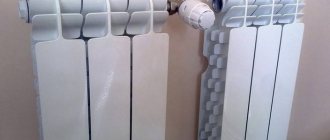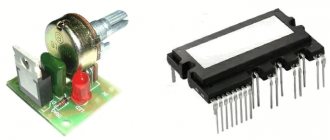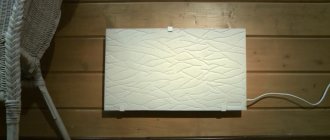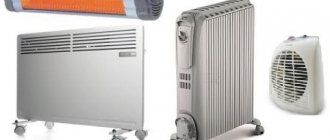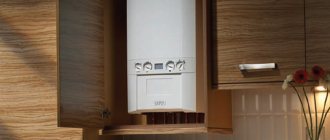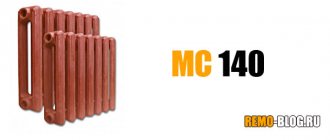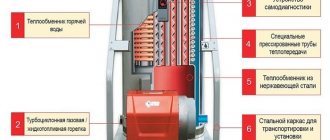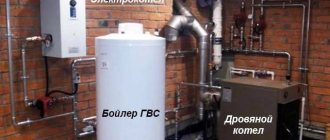In addition to halogen and quartz heating devices, there is another, youngest type of infrared heating device - a carbon heater. The freshness of the development implies the use of modern technologies in the device, which is indeed the case in this unit, so we will consider the carbon heater in more detail in order to better navigate the wide range of household appliances identical in purpose when purchasing.
Carbon heater design
The design of this type of heating device differs little from the design of most types of infrared heating devices. The main element of the electric heater is placed inside a metal or ceramic case with a reflector (reflector), which can be located in the case both horizontally and vertically.
The reflector provides the direction of the concentrated radiation flux, which can also be adjusted by a mechanical rotating device, available on most models.
Carbon lamp structure
This emitter lamp is a quartz glass tube sealed at the ends, into which an incandescent filament made of a special carbon fiber - carbon - is placed under vacuum conditions.
Carbon was chosen as a filament for a reason - an infrared emitter of this design operates in the long-wave range, eliminating the factor of undesirable long-term exposure to short-wave radiation on humans. In addition, the service life of carbon lamps is on average 100 thousand hours, which in terms of months of the heating season is approximately 10 calendar years.
The long service life is due to the fact that the coefficient of linear thermal expansion of carbon fiber, in contrast to tungsten or nichrome, is close to zero, and carbon fiber by definition does not have a factor of metal fatigue from thermal deformation when turning the device on and off.
Operating principle of the device
After installing or mounting the device, the reflector is manually directed in the desired direction and fixed. The device is connected to a household network with a voltage of 220/230 V and almost instantly reaches its maximum heat emission power. The heat transfer efficiency of carbon is higher than that of metals, since it requires almost no energy to heat the filament to the radiation temperature, while the quartz glass of the tubes transmits radiant heat without loss. This explains the cost-effectiveness of carbon heaters compared to other lamp infrared heaters.
Heating of the room is ensured by heating the objects to which the heater is directed, with their subsequent release of heat into the air environment of the room. There is no radiation energy consumption to increase the air temperature when waves pass through it, since the energy of long-wave infrared radiation from carbon is absorbed only by dense media. In this case, not only the surfaces of the room’s furnishings are heated, but also their internal heating to a depth of 2 cm, which helps to extend the heat transfer time after the heater is turned off. Many models of carbon units are equipped with a thermostat that allows you to maintain a certain temperature in the room.
Like all modern electric heating devices, the carbon heater has an automatic shutdown device in the design if it falls, rolls over, or is tilted at a dangerous angle.
Important! Prolonged presence of a person in the path of long-wave radiation from a carbon lamp, if a safe distance is maintained to prevent thermal burns, is absolutely harmless.
Types of carbon heating devices
Carbon heating devices are manufactured portable (floor-mounted, tripod-mounted) or designed for installation on a wall or ceiling. These types of construction differ from each other only in the way they are positioned and attached to the base.
There is also a classification based on the orientation of the heating elements in the housing:
- horizontal;
- vertical.
Of these two designs, select the one that corresponds to the most rational placement of the device at the site of operation.
Models of carbon heaters also differ in the number of heating elements. Naturally, the more of them, the more efficient the device will be, but the more significant is the electricity consumption
By power, carbon heating devices are divided into household ones - from several tens of watts to 2-3 kilowatts and industrial, multi-kilowatt, used for heating industrial premises or ensuring the temperature regime in drying chambers.
Do-it-yourself device with a carbon heater
A homemade device operating on the principle of a carbon film can be built on your own from scrap materials. When performing such work, it is important to thoroughly dry all workpieces, check the power so that it can be safely connected to the network and pay special attention to insulation.
According to homemade craftsmen, a heater assembled with their own hands is not inferior in performance to purchased analogues. To make it you will need epoxy glue, copper terminals, a wire with a plug for connecting to the network, graphite powder, 2 sheets of laminated paper plastic.
You can crumble graphite powder yourself by finding suitable waste material for this.
To obtain a graphite conductor, you need to mix epoxy glue with graphite powder. Stir the mixture thoroughly - it will serve as a heating element.
The resulting conductor must be applied in a zigzag pattern to the prepared sheet. Then you need to glue the sheets of plastic together with glue, attaching copper terminals to the conductor on different sides. You can also connect a thermostat, which will help regulate the temperature after the heater is assembled.
The device, assembled by yourself, is easy to use. Its assembly does not require any special parts that are impossible to obtain. It is important to isolate everything well and be sure to test the capabilities of the created homemade product
Having carefully fastened everything, you have to leave the workpiece to dry completely. All contacts, wires and parts carrying current should be properly insulated. After drying, be sure to measure the resistance of the device and calculate its power. Without these tests, it is strictly forbidden to connect the device to the network.
Advantages and disadvantages
The carbon heater, as the youngest, is the most advanced unit among lamp heating devices, which also determines its higher technical characteristics. Let's list the pros and cons of these devices, both inherent in all infrared heaters and characteristic only of carbon units.
- High efficiency – close to 95%.
- Economical:
- low level of energy consumption - due to the high thermal conductivity of carbon, which allows it to consume almost half as much electricity to generate a unit of heat as most traditional types of electric heaters;
- the long service life of the unit is also ensured by the unique properties of the carbon fiber.
- Lack of short-wave radiation - long-wave radiation from carbon does not have a harmful effect on humans and does not change the characteristics of the air in the room (humidity, oxygen content).
- High degree of safety of use.
- Wide range of design and construction options.
- Compact and light weight (2-4 kg).
- Optimal level of automation of the heater operation (thermostat, tilt sensor, remote control).
- Easy to use and daily care.
- Quiet operation.
- Affordable price.
The list of advantages of a carbon heater is impressive, but there are also disadvantages:
- low efficiency of directional heating in the fresh air - due to the characteristics of long-wave radiation;
- high probability of destruction of quartz tubes of carbon lamps if the device is accidentally dropped;
- the inability of long-wave radiation to bend around obstacles - an object that is in the path of the rays will be heated.
The listed disadvantages are not critical, and rather serve an informative function rather than determine the choice of device when purchasing.
Carbon heaters: pros and cons, price and main characteristics
New types of heating include carbon heaters. The pros and cons, price and parameters of these products need to be studied before purchasing. These are compact designs with fast heating. In their design they have a vacuum quartz tube with carbon fiber. They warm up not the surrounding air, but objects. Such devices can even be installed outdoors.
This device can be used as an addition to the main heating system.
Advantages of designs
To better understand what carbon heaters are, read reviews on the forums of users of this equipment. The main advantage of this design compared to fan heaters is their high performance and low energy consumption.
The unit can be used on verandas and attics
The advantages include:
- the presence of a powerful heat flow;
- the installation is protected from moisture penetration;
- in case of problems with the network or accidental overturning, the structure immediately turns off;
- possibility of directional heating;
- compact and silent operation.
This is how the design works and distributes heat
Such devices also have a healing effect. They are used for some medical indications. When choosing a suitable product, pay attention to the characteristics of a particular room. It is important to clarify the number of windows, ceiling heights and the number of people living.
Disadvantages of carbon heaters
Before buying an infrared carbon heater, find out more information about the disadvantages of this equipment. The main disadvantage of the device is the fragility of the quartz tube. Because of this, the device may become unusable if dropped or subjected to a strong impact.
It is better not to drop such a device
How to choose a carbon heater
When purchasing, you first need to decide on the installation location of the unit. If there is no permanent location, that is, the device is expected to be moved as needed, then you should choose a portable device - floor-standing or tripod.
Versions with vertical heating elements are more compact and preferable for small rooms. At the same time, the power of portable carbon heating devices usually does not exceed 2 kW, which makes it possible to provide the desired temperature in a room of up to 20 square meters.
To protect children and pets from contact with devices, it is better to give preference to a wall or ceiling modification, choosing a carbon heater with the ability to rotate the reflector to a maximum angle for even greater ease of use. At the same time, the strength of the brackets and the reliability of the design of fastening the unit to the base should be mandatory conditions for choosing wall-mounted carbon heating devices.
Important! The power cable of the device must have a grounding conductor connected to the body of the device, and carbon lamps must have a protective metal grid.
The reflector material must be made of dense foil that resists finger pressure, and the heater body must be protected from corrosion by a high-quality paint coating without chips or scratches.
The performance of a carbon heating device and its automatic systems is checked on site upon purchase; the manufacturer’s operating instructions must be supplied with the device.
Flaws
An infrared carbon heater also has certain disadvantages:
1. Carbon fiber threads wear out relatively quickly.
2. The quartz tube may break if subjected to strong impact. Naturally, for this you need to be very careless with the device.
In principle, these are all the shortcomings of the presented device. However, it is not yet so popular among buyers due to prejudice. That is, users believe that the radiation from such a heater can be harmful. Whether this is true or not, you will find out later.
Rules of use and safety precautions
To prevent accidents associated with electrical injuries and burns, as well as to ensure the heater service life declared by the manufacturer, the following safety rules must be followed:
- It is prohibited to place heaters in close proximity to flammable objects (curtains, tablecloths, floor and table lamp shades, etc.).
- Drying items on electric heaters is not allowed.
- It is prohibited to place electrical cables under carpets, moving door leaves, or in areas of high humidity or water in the open.
- It is also prohibited to leave heaters on unattended.
- Repairs to carbon heaters should only be carried out by qualified specialists.
Following these rules will protect users not only from accidents, but also from disappointment in these modern, functional home heaters.
Types of devices
Now we should consider the classification of the presented devices. They are different.
— Floor carbon heaters. They can be on a leg or on a low platform. They are best used for a short time.
- Ceiling. Such structures can be built into suspended ceilings.
— Wall-mounted. This type of device is probably the most common. Such devices are considered the most convenient to use and manage. This option is most acceptable if there is a small child in the house.
